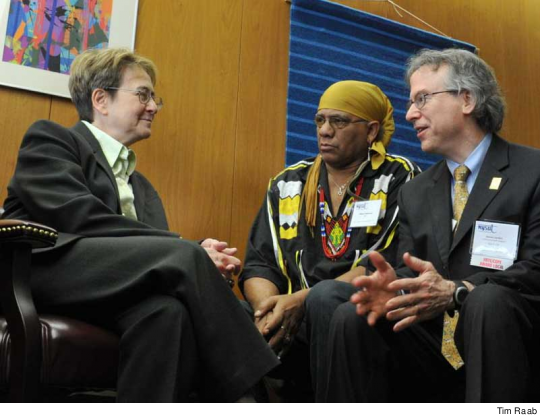Pressing for fair State funding for CUNY, PSC activists met with legislators in Albany and in their home districts in February and March 2013.
Okena Littlehawk, a College Lab Technician at Bronx Community College, joined a grassroots lobbying group on March 5, 2013, his second trip to Albany with a PSC delegation. The first time was to apply pressure of a different sort: “That was in 2011, for our anti-austerity direct action on 2011,” he told Clarion. Littlehawk was then one of 33 people arrested in a PSC sit-in against deep budget cuts, at the ornate entrance to the governor’s chambers inside the Capitol building.
Littlehawk said he had signed up for both lobbying and direct action because at his campus, BCC, the need for more resources is urgent. “When I put out my orders for things needed to run my microbiology classes, I can’t always count on getting them,” he told Clarion. “We need microscopes, media, cultures – we’re being asked to make bricks without straw.”
 |
Alumni Indignation
Berkis Cruz-Eusebio, who works in the ASAP program at Hostos CC, led one of five groups of PSC members in the March 5 lobbying effort. She said the union’s message touched a particular chord with legislators who are themselves CUNY graduates. “I was impressed with their indignation…when they reviewed the consistent decrease in State aid,” Cruz-Eusebio said. “Our students, with family income averages of under $20,000, are covering 43% to 46% of CUNY’s costs with tuition payments – yet they are expected to do more!”
The PSC’s call for change was the focus of testimony delivered by First Vice President Steve London, at a joint legislative budget hearing February 11.
Governor Cuomo’s executive budget proposal calls for essentially flat funding for CUNY in the coming fiscal year. But while it does not propose drastic cuts, it does not provide funding for $35 million of CUNY’s mandatory expenses. Some money is allotted for increases in fringe benefit costs, but CUNY’s additional costs for energy, rent, collective bargaining and some other areas are left unfunded.
“Flat funding is, in fact, a cut to CUNY’s budget, because it does not account for inflation,” London said. He called for funding for the missing $35 million, and for changes in the law to include mandatory cost increases in the definition of level funding.
But fully funding CUNY’s current costs is far from enough, the PSC contends. Many years of austerity have left CUNY struggling to continue its role as “a jewel of opportunity” for the people of New York, London told legislators.
“Revenue from State aid per full-time equivalent [FTE] student fell 39.2% between 1990-91 and 2012-13 at CUNY’s senior colleges, when adjusted for inflation,” he said. “At the community colleges, State aid per FTE student fell 43%” in the same period.
State base aid per FTE student at CUNY’s community colleges has fallen sharply, down by 35% since 1990-91 and by 21% in just the last three years. The latter has meant a loss of $48 million in State support.
“CUNY needs public funds to make up for years of State disinvestment,” London testified. The shortfall in State support has translated into a lack of full-time faculty and reliance on exploitation of adjuncts: while CUNY’s goal is to have 70% of instruction by full-time faculty members, it remains below 50% – and in fact declined from 49% to 46% in the four years before 2011.
As State funding has been cut, the proportion of CUNY’s budget that comes from student tuition has risen sharply. “Student tuition, fees and other revenue now supply 48% of CUNY senior college revenue, up from 38% in 2000-01 and 21% in 1990-91,” London pointed out. In 1990-91, he added, State funding supplied 74% of CUNY senior college revenue; now the state supplies only 51%.
“Turning CUNY into a privately financed institution through tuition dollars will close the door of opportunity to many New Yorkers,” London said. Relying on tuition hikes to make up for decades of State disinvestment has already proven to be a failed strategy, he emphasized: students have shouldered an increasing burden, yet CUNY’s finances continue to struggle. Many students cannot afford CUNY’s current $300-a-year tuition hikes, he added. If tuition were to be raised enough to make up for past cuts in State support, “the magnitude of the tuition increase that would be needed…is so great that CUNY’s mission would be compromised by pricing out the City’s low and middle-income students.”
The Tuition Assistance Program, or TAP, cannot be relied on to avoid these consequences, London said. “Tens of thousands of poor students are ineligible for TAP,” including most part-time students and those who are undocumented. And only half of CUNY’s full-time students in 2011 qualified for TAP. The PSC strongly supports the NYS DREAM Act, he noted, which would make undocumented students eligible for TAP (see Clarion, February 2013), and supports other TAP reforms. But the need to reverse State disinvestment in CUNY will still remain, he said.
Unfair Linkage
The PSC strongly opposes Governor Cuomo’s proposed “Next Generation Job Linkage Program,” which would tie some community college funding to so-called “performance” measures and partnerships with private business. “Shifting to performance-based funding would ignore the many challenges faced by community college students, and [ignores] the years of State disinvestment that have already undermined CUNY’s community colleges,” London said. (Full text of the PSC testimony is at tinyurl.com/PSC-testimony-State-2013).
To find out more about the PSC’s CUNY budget campaign, and how you can help, click here.

